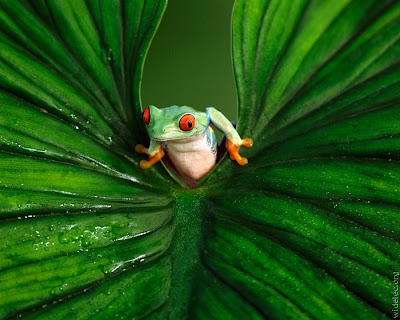
The Red-eyed Tree Frog (Litoria chloris) found in eastern Australia.
The habitat of frogs extends almost worldwide, but they do not occur in Antarctica and are not present on many oceanic islands.[27][28] The greatest diversity of frogs occurs in the tropical areas of the world, where water is readily available, suiting frogs' requirements due to their skin. Some frogs inhabit arid areas such as deserts, where water may not be easily accessible, and rely on specific adaptations to survive. The Australian genus Cyclorana and the American genus Pternohyla will bury themselves underground, create a water-impervious cocoon and hibernate during dry periods. Once it rains, they emerge, find a temporary pond and breed. Egg and tadpole development is very fast in comparison to most other frogs so that breeding is complete before the pond dries up. Some frog species are adapted to a cold environment; for instance the wood frog, whose habitat extends north of the Arctic Circle, buries itself in the ground during winter when much of its body freezes.
Golden Toad

Golden toad (Ollotis periglenes) - last seen in 1989
The golden toad (Bufo periglenes) was a small, shiny, bright true toad that was once abundant in a small region of high-altitude cloud-covered tropical forests, about 30 square kilometers in area, above the city of Monteverde, Costa Rica. For this reason, it is sometimes also called the Monteverde golden toad, or the Monte Verde toad. Other common English names include Alajuela toad and orange toad

Poison

Oophaga pumilio (formerly known as Dendrobates pumilio), a poison dart frog, from Costa Rica, Central America.
Many frogs contain mild toxins that make them unpalatable to potential predators. For example, all toads have large poison glands—the parotoid glands—located behind the eyes on the top of the head. Some frogs, such as some poison dart frogs, are especially toxic. The chemical makeup of toxins in frogs varies from irritants to hallucinogens, convulsants, nerve poisons, and vasoconstrictors. Many predators of frogs have adapted to tolerate high levels of these poisons. Others, including humans, may be severely affected.







CLICK NOW
COLLECTION OF WORLD'S BEST WALLPAPERS
WOW WHAT A BEAUTY
AMAZING NATURE
NATURE OF GOD
JAZZ OF LIFE
COOL PHOTOS BANK
BEAUTY OF WILDLIFE
BEST PHOTOS OF THE WORLD
No comments:
Post a Comment